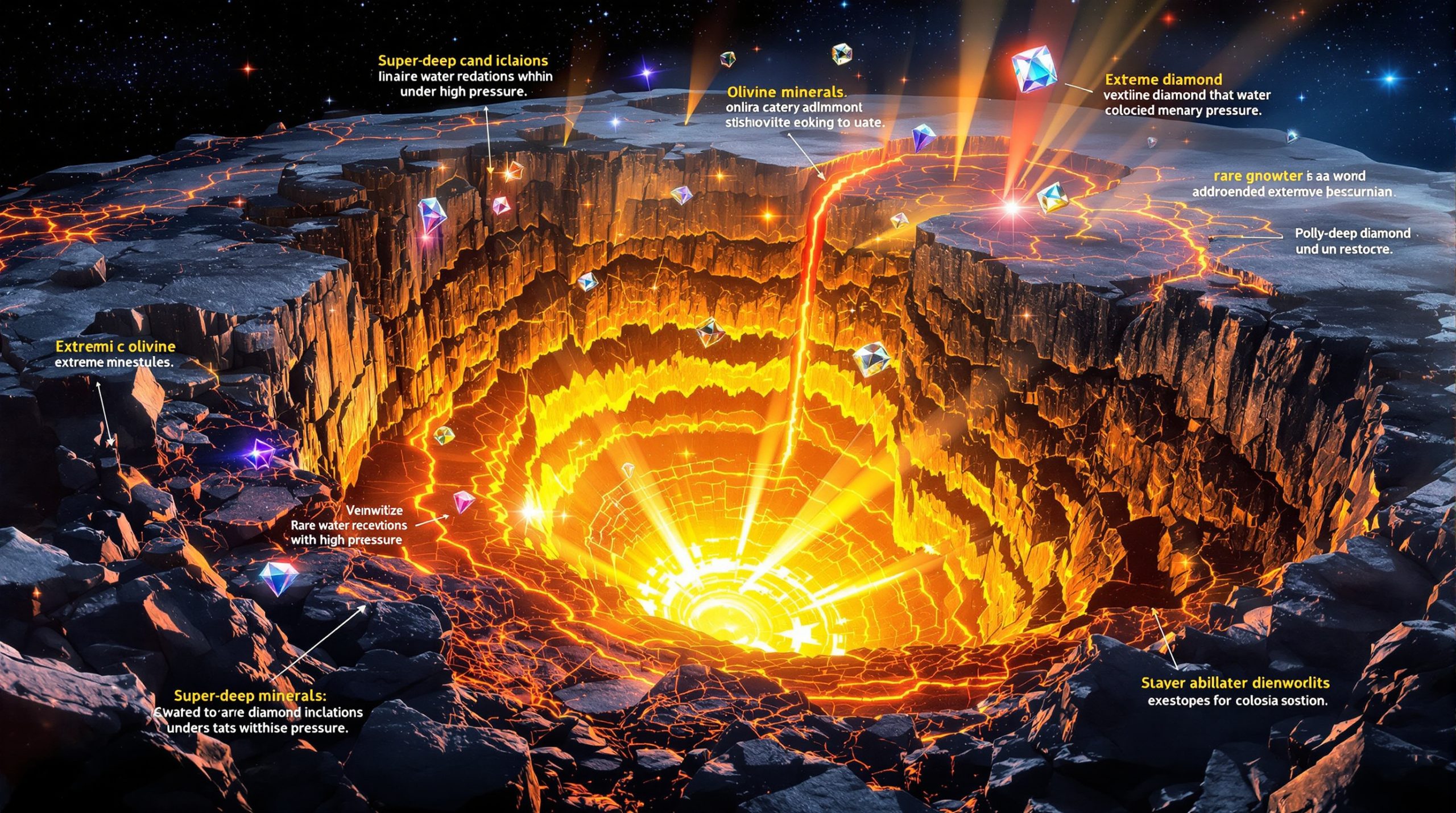Macro Trends and Mantle Mysteries: Unlocking Earth’s Extreme Minerals
The search for extreme minerals of Earth's mantle exposes a world of hidden matter, forged well beyond ordinary geology. These ancient compounds emerge beneath Earth’s crust under searing heat and crushing pressure. In addition, they offer clues that reshape our understanding of planetary formation and materials science.
Deep beneath the surface, processes occur at cosmic scales. Volcanic activity, tectonic shifts, and extreme pressure give rise to extraordinary compounds. Furthermore, ongoing research continues to shed light on these elusive treasures.
Why Are Mantle-Derived Extreme Minerals a Scientific Game-Changer?
The Earth’s mantle spans roughly from 35 to 2,900 kilometres below the surface. This region undergoes extraordinary stress and heat. In addition, the mantle’s transition zone between 410 and 660 km witnesses dramatic mineral transformations. Temperatures exceed 1,200°C, while pressures climb above 130,000 atmospheres.
Key characteristics qualifying these minerals include:
• Formation under pressures above 13 GPa – far beyond conditions at the surface.
• Stability at temperatures above 1,000°C – many require even higher heat to form.
• Unique trace element combinations that hint at deep chemical processes.
Techniques such as mantle xenolith sampling have proven invaluable. Volcanic eruptions can bring fragments like peridotite and eclogite to the surface. Moreover, these rare pieces are studied extensively using tools like diamond anvil cells. In fact, advanced laboratories report subtle shifts in atomic structures using drill results interpretation.
In parallel, the latest research highlights the mineral exploration importance of these discoveries. Scientists are increasingly realising that every fragment provides additional details about Earth’s deep interior.
What Are the Unique Chemistries and Structures of Earth’s Deepest Minerals?
Extreme pressure forces minerals to adopt surprising atomic arrangements. Researchers have identified polymorphism as a key adaptation mechanism. In other words, a single chemical formula can produce different structures depending on the environment.
For instance, olivine transforms into ringwoodite under pressures above 13 GPa. In addition, quartz can convert to stishovite when subjected to sufficient compression. These shifts are fundamental to understanding deep mantle processes.
A comparison table summarises these transformations:
• Olivine:
– Surface: Forsterite (4-fold silicon)
– Deep: Ringwoodite (6-fold silicon)
– Pressure >13 GPa
• Quartz:
– Surface: Quartz (4-fold silicon)
– Deep: Stishovite (6-fold silicon)
– Pressure >10 GPa
• Garnet:
– Surface: Pyrope (8-fold magnesium)
– Deep: Majorite (8/12-fold mixed coordination)
– Pressure 14–23 GPa
Moreover, the study of these compounds is enhanced by tools that simulate Earth’s interior conditions. For instance, recent laboratory experiments using diamond anvil cells have replicated mantle conditions with impressive accuracy. In fact, findings on mineralogy & mining economics suggest that the deeper we explore, the more parallels arise between natural and synthetic material properties. Additionally, insights into mantle layers can be gathered by exploring resources such as mantle layers.
How Do Atomic Structures Adapt Under Enormous Pressure?
Polymorphism illustrates nature’s adaptability. Atomic lattices rearrange, leading to multiple structures from a single compound. This phenomenon is evident in minerals like ringwoodite and stishovite. Notably, ringwoodite traps up to 2.6 wt% H₂O – a discovery that has significant implications for Earth’s water cycle.
In addition, structural changes help explain the differences between surface rocks and their deep-mantle counterparts. For instance, the transition to a six-fold coordination in quartz to form stishovite is a prime example of atomic reorganisation. These adaptations are critical in shaping our understanding of Earth’s interior dynamics.
Why Are Mantle Minerals Structurally Unprecedented?
Deep Earth chemistry is considerably more complex than what is observed on the surface. Extreme conditions encourage minerals to incorporate unusual elements. Consequently, trace elements such as rare earths, iron, or zirconium may substitute seamlessly in the crystal lattice.
For instance, minerals like udyliite and majorite form intricate 3D networks. Their frameworks consist of rings, chains, and clusters that support a complex solid solution. In addition, pineite integrates elements like zirconium, boron, vanadium, and chromium under very specific conditions. This complexity underpins both their chemical uniqueness and limited occurrence.
Furthermore, advanced imaging techniques, including synchrotron X-ray diffraction, have allowed scientists to visualise these atomic networks. Not only do these methods reveal coordination numbers, but they also elucidate how elements coexist at high pressures. In parallel, recent studies on mining industry evolution consider these findings vital for designing future materials.
Which Mantle Minerals Redefine Rarity, Age, and Origin Stories?
Some minerals chronicle events that span billions of years. Extreme minerals are records of both cosmochemical and geologic evolution. For instance, hibonite first formed in high-temperature solar nebulae billions of years ago. Interestingly, these minerals now provide evidence of early solar system processes.
A tabulated summary of select minerals is as follows:
• Pineite:
– Rarity: ~1,000,000x rarer than diamond
– Notable for its unique elemental lattice
– Typically found in pegmatites from Myanmar
• Tophite:
– Rarity: Equally uncommon
– Distinct hexagonal structure with Be and Mg
– Collector-discovered specimens typically reveal its presence
• Hibonite:
– Exclusively meteoritic
– Known as the oldest solar system mineral
– Found in carbonaceous chondrites
Moreover, minerals such as geromeite are known from singular localities due to rapid growth under unique conditions. These discoveries underpin our geological history and feed into evolving models that describe Earth’s interior.
What Unexpected Physical and Chemical Behaviours Stand Out?
Extreme minerals exhibit phenomena that have challenged engineers and physicists for decades. Their properties range widely, from luminescence to semiconductivity. For example, ulexite channels light in a manner reminiscent of modern fibre optics. Similarly, fluorite’s ability to glow under UV radiation gathers interest from optical physicists.
In addition, natural semiconductors such as bismuthinite inspire advancements in electronic components. Furthermore, moissanite – a form of silicon carbide – demonstrates extraordinary hardness. Interestingly, it is second only to diamond, offering insights for industries seeking high-strength materials.
Recent experiments highlight surprising mineral behaviour in these compounds. Furthermore, studies indicate that such behaviours could translate into technological breakthroughs.
How Are Mantle Mineral Discoveries Transforming Earth Science and Technology?
Research into these extreme minerals of Earth's mantle has led to transformative developments. Notably, the discovery of water-bearing ringwoodite within diamonds has revolutionised our understanding of Earth’s water cycle. For instance, if even 1% H₂O is present in the transition zone, the water content could surpass that on the surface. This insight is crucial for hydrological studies.
Similarly, kimberlite-borne xenoliths provide snapshots of deep mantle dynamics. Their analysis enables scientists to reconstruct historical convection patterns and appreciate the recycling of oceanic slabs. Additionally, studies on asteroid mining advances fuel ideas for extracting resources from extraterrestrial bodies.
Technology, too, benefits from these discoveries:
• Advanced ceramics and abrasives now utilise moissanite’s durability.
• Natural semiconductors and sensors benefit from the unique charge transfer of minerals such as bismuthinite.
• Novel synthetic materials mimic the atomic frameworks of deep-mantle compounds, offering heat-resistant and high-strength solutions.
Can Mantle Minerals Guide Future Planetary Exploration?
Extreme minerals of Earth's mantle serve as planetary signatures. They guide scientists in comparing seismic and mineralogical data across celestial bodies. For example, studying these minerals helps contrast Earth with the Moon or Mars. Furthermore, these insights inform future space missions that may target similar high-pressure silicates.
In addition, ancient refractory minerals such as hibonite offer chemical clues about early solar nebula processes. Consequently, these minerals may even provide hints regarding the origin of life. The interdisciplinary approach, combining geology with astrochemistry, continues to inspire novel exploration missions.
FAQ: Extreme Mantle Minerals—Key Questions Answered
Q: Can we directly mine the deepest mantle minerals?
A: With current technology, direct mining is unfeasible. Most specimens arrive naturally through volcanic eruptions or as diamond inclusions.
Q: What is the hardest deep-mantle mineral?
A: Moissanite ranks close to diamond in hardness, while high-pressure minerals like stishovite are among the densest silicas known.
Q: Are there safety risks in studying these materials?
A: Some, such as uraninite, are radioactive and require strict laboratory protocols.
Comparative Analysis Table: Notable Mantle and Cosmic Extreme Minerals
• Ringwoodite:
– Formation: 525–660 km deep
– Elements: Mg, Si, H₂O
– Unique: Significant water storage capability
• Stishovite:
– Formation: Impact zones or deep mantle
– Elements: Si, O
– Unique: Highest-density form of SiO₂
• Pineite:
– Formation: Pegmatites
– Elements: Zr, B, V, Cr
– Unique: Exceptionally rare and complex chemistry
• Moissanite:
– Formation: Meteorites or deep mantle
– Elements: Si, C
– Unique: Exceptionally hard, nearly rivaling diamond
• Hibonite:
– Formation: Meteorites exclusively
– Elements: Ti, Ca, Al
– Unique: Represents early solar system materials
• Lodestone:
– Formation: Surface or near-surface events
– Elements: Fe, O
– Unique: Displays natural magnetism
How Should Scientists and Technologists Approach the Mantle’s Mineral Diversity?
Research into extreme minerals of Earth's mantle demands a multi-disciplinary approach. First, fostering collaboration among mineralogists, engineers, and planetary scientists is vital. Second, promoting open data and sample sharing accelerates understanding.
Furthermore, ethical stewardship is essential when handling rare and sometimes hazardous samples. In addition, efforts in synthesising these compounds may unlock new industrial applications. This evolving field stands as a testament to both natural ingenuity and human innovation.
Conclusion: From Mantle Mysteries to Modern Marvels—Future Directions
The study of extreme minerals of Earth's mantle has revolutionised our geological insights. This is the third mention of the phrase. These discoveries continue to inspire collaborations across disciplines and spur technological innovation. In addition, future exploration missions may well draw on these findings to guide planetary resource extractions.
In conclusion, extreme minerals of Earth's mantle not only elucidate our planet’s history but also offer tangible benefits for modern science and technology. This is the fourth and final mention of the keyword. Their study remains a vibrant frontier, driving both academic inquiry and industrial advancement.
Are You Ready to Unearth the Next Big Discovery?
Tap into the potential of mantle-derived minerals and their transformative role in earth sciences with Discovery Alert’s cutting-edge alerts. Visit the Discovery Alert discoveries page and discover how our proprietary Discovery IQ model gives investors a critical advantage with immediate real-time alerts on significant ASX mineral discoveries.




